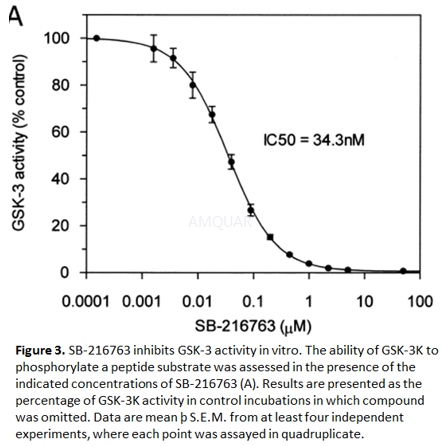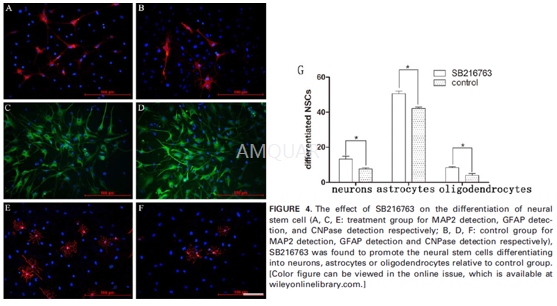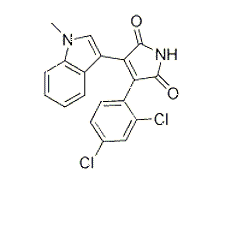-
生物活性
SB216763 is a cell-permeable, potent, selective and ATP-competitive inhibitor of GSK-3 (Glycogen Synthase Kinase) with an IC50 value of 34 nM for GSK-3α and with similar potency for GSK-3β. In PC-12 cells, SB216763 exhibits neuroprotective properties and protects cultured central and peripheral nervous system neurones from cell death. Furthermore, SB216763 increases the concentration of cytoplasmic β-catenin through a GSK-3 dependent manner. These inhibitory effects are similar to those of Wnt. Exhibits minimal activity against 24 other protein kinases (IC50 >10 μM). Stimulates glycogen synthesis in liver cells, and induces β-catenin-dependent gene transcription.
SB-216763 stimulated glycogen synthesis in the Chang human liver cell line with EC50 of 3.6μM.[1] The inhibition of glycogen synthase kinase-3(GSK-3) in human[1]

In cultured bovine adrenal chromaffin cells, SB216763 decreases Akt1 level by ~67% (EC50=2μM; t1/2=12h); in adrenal chromaffin cells, SB216763 increases β-catenin level by ~47% (EC50=1μM; t1/2=12h).[2]
-
体外研究
-
体内研究
1% DMSO+30% polyethylene glycol+1% Tween 80
-
激酶实验
GSK-3 activity assay[1]
GSK-3 kinase activity was measured, in the presence or absence of SB-216763 in a reaction mixture containing final concentrations of: 1 nM human GSK-3K or rabbit GSK3K; 50mM MOPS pH 7.0; 0.2mM EDTA; 10mM Mg-acetate; 7.5mMβ-mercaptoethanol; 5% (w/v) glycerol; 0.01% (w/v) Tween-20; 10% (v/v) DMSO; 28μM GS-2 peptide substrate. The GS-2 peptide sequence corresponds to a region of glycogen synthase that is phosphorylated by GSK-3. The assay was initiated by the addition of 0.34μCi [33P]γ-ATP (IC50 determinations) or 2.7μCi [33P]γ-ATP (Ki determinations). The total ATP concentration was 10μM (IC50 determinations) or ranged from 0 to 45μM (Ki determinations). Following 30 min incubation at room temperature the assay was stopped by the addition of one third assay volume of 2.5% (v/v) H3PO4containing 21mM ATP. Samples were spotted onto P30 phosphocellulose mats and these were washed six times in 0.5% (v/v) H3PO4. The filter mats were sealed into sample bags containing Wallac betaplate scintillation fluid.33P incorporation into the substrate peptide was determined by counting the mats in a Wallac microbeta scintillation counter.

-
细胞实验
Cell culture[3]
The cerebral cortex were isolated from 5 days old SD rats, cut into 1 mm3 pieces and digested in 0.25% trypsin for 10 min. Then the digestion was stopped by adding serum-contained medium, followed by filtering through 100 mesh and centrifugation at 1000 rpm for 5 min. The cell suspension was cultured in 25 cm2tissue culture flask in serum-free DMEM/F12 medium containing 20ng/ml bFGF , 20ng/mL EGF (Life tech, NY), 2% B27 . As to C6 glioma cell, it was cultured in DMEM/F12 medium containing 15% newborn calf serum, 100U/ml penicillin and 100U/ml streptomycin. The source of C6 glioma cell is the brain of rat. The culture condition was at 37oC and in a humidified atmosphere containing 5% CO2.
The effect of SB216763 on the differentiation of neural stem cell
The experiments were divided into two groups including control group and SB216763 group. The SB216763 was added to the culture medium at the concentration of 10μM. The bottom of 24-well plate was covered with coverslip and the neural stem cells were seeded in the 24-well plate at the density of 1 x 104cells/ml.

-
动物实验
Pharmacological Agents[4]
Morphine hydrochloride was dissolved in water, whereas wortmannin and SB216763 (SB) were dissolved in a final concentration of 0.01% dimethyl sulfoxide.
In Vivo Coronary Occlusion-Reperfusion
Male Wistar rats (150–200 g) were used for these experiments. In all groups of rats, the coronary artery was occluded for 35 min and released for a 2-h reperfusion before mitochondrial functional assessment and infarct size measurement. Mitochondrial functional assessment was also made after a 10-min reperfusion because it was demonstrated that mPTP opens within the first min of reperfusion. In the sham group in which the surgical procedure was identical to others, the coronary artery was not occluded. In the other groups of treated rats, i.e., vehicle control, morphine (0.3 mg/kg) or SB (0.6 mg/kg) was administered separately as a 3-min infusion through the jugular vein at 5 min before reperfusion.
Infarct Size Determination
After completion of reperfusion, rats received heparin (1000 UI/kg) and were re-anesthetized with sodium pentobarbital (60 mg/kg). After thoracotomy, the coronary artery was re-occluded at the same place as previously used to induce myocardial infarction. Potassium chloride was used to induce cardiac arrest, and the hearts were excised. The ascending aorta was cannulated and perfused retrogradely (Langendorff apparatus, 100 mmHg) with saline solution followed by 5% Evans blue. Infarct size was determined as the percentage of the area at risk (AAR). The left ventricle was cut from apex to base into six slices, which were weighed and incubated with 1% triphenyltetrazolium chloride in a pH 7.4 buffer for 20 min at 37°C. Slices were fixed overnight in 10% formaldehyde and then photographed with a digital camera mounted on a stereomicroscope. Using a computerized planimetric program, AAR and the infarcted zones were quantified. AAR was expressed as a percentage of the left ventricle weight, and infarct size was expressed as a percentage of AAR.

-
不同实验动物依据体表面积的等效剂量转换表(数据来源于FDA指南)
|  动物 A (mg/kg) = 动物 B (mg/kg)×动物 B的Km系数/动物 A的Km系数 |
|
例如,已知某工具药用于小鼠的剂量为88 mg/kg , 则用于大鼠的剂量换算方法:将88 mg/kg 乘以小鼠的Km系数(3),再除以大鼠的Km系数(6),得到该药物用于大鼠的等效剂量44 mg/kg。
-
参考文献
[1] Matthew P Coghlan AAC, Darren AE Cross , Stacey L Corcoran , John W Yates , Nigel J Pearce , Oliver L Rausch , Gregory J Murphy. Selective small molecule inhibitors of glycogen synthase kinase-3 modulate glycogen metabolism and gene transcription. Chem Biol. 2000;7(10):793-803.
[2] Nemoto T, Kanai T, Yanagita T, et al. Regulation of Akt mRNA and protein levels by glycogen synthase kinase-3beta in adrenal chromaffin cells: effects of LiCl and SB216763. Eur J Pharmacol. 2008;586(1-3):82-89.
more
分子式
C19H12Cl2N2O2 |
分子量
371.22 |
CAS号
280744-09-4 |
储存方式
﹣20 ℃冷藏长期储存。冰袋运输 |
溶剂(常温)
|
DMSO
≥25 mg/mL |
Water
<1 mg/mL |
Ethanol
<1 mg/mL |
体内溶解度
11 mg/mL
-
Clinical Trial Information ( data from http://clinicaltrials.gov )
注:以上所有数据均来自公开文献,并不保证对所有实验均有效,数据仅供参考。
-
相关化合物库
-
使用AMQUAR产品发表文献后请联系我们





















